Events Date of event: July 9, 2019 Ceremony Held to Celebrate 30th Anniversary of HFSP
Conference Report
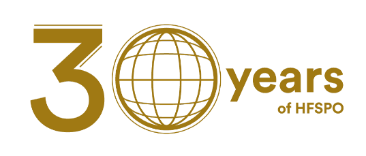
A ceremony was held on July 9, 2019, to celebrate the 30th Anniversary of the Human Frontier Science Program (HFSP)*1 at the Hitotsubashi Hall (Chiyoda-ku, Tokyo). Approximately 400 guests gathered from around the world, including HFSP awardees, delegates from management supporting parties, and Japanese high school students.
The first part of the ceremony kicked off with an opening remark from NAGATA Shigekazu , president of the Human Frontier Science Program Organization (HFSPO).*2 “Founded 30 years ago at the initiative of then Prime Minister NAKASONE Yasuhiro, HFSP has expanded its membership from the initial G7 nations to 15 countries, with 28 HFSP awardees going on to win the Nobel Prize,” he stated. “I would like to express my appreciation for the contributions made by the governments of our member nations.”
Also, guest speaker SHIBAYAMA Masahiko, Minister of Education, Culture, Sports, Science and Technology (MEXT), greeted the audience. “HFSP is shaped by three factors: originality, internationality, and support for young researchers. The program will continue supporting the promotion of basic research and human resources development.” The minister was followed by ISOZAKI Yoshihiko, the State Minister of Economy, Trade and Industry (METI), who stated, “I have high hopes that HFSP will promote global innovation, interdisciplinary integration, and collaborations between industry, government, and academia.”
NAKASONE Hirofumi, member of the House of Councillors, National Diet of Japan, talked about his father, former prime minister NAKASONE Yasuhiro, saying, “He is fit and well at the age of 101, and was tremendously disappointed about not being able to attend this ceremony. He still has great interest in HFSP, and is delighted by its development.” Next, an introduction of the HFSP Nakasone Award*3 was given by Warwick Anderson, secretary-general of HFSPO. Mr. Nakasone then presented the award to Michael Hall, professor of Biozentrum, University of Basel, Switzerland, in recognition of his 1991 discovery of the target of rapamycin (TOR), which controls cell growth. The discovery subsequently contributed significantly to the advancement of research on cancer, metabolic syndrome, type 2 diabetes and other diseases.
-
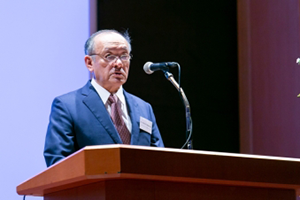 NAGATA Shigekazu, President of HFSPO
NAGATA Shigekazu, President of HFSPO
-
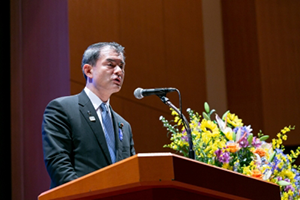 SHIBAYAMA Masahiko, Minister of MEXT
SHIBAYAMA Masahiko, Minister of MEXT
-
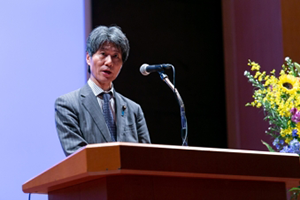 ISOZAKI Yoshihiko, State Minister of METI
ISOZAKI Yoshihiko, State Minister of METI
-
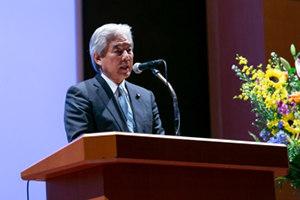 NAKASONE Hirofumi, member of the National Diet
NAKASONE Hirofumi, member of the National Diet
-
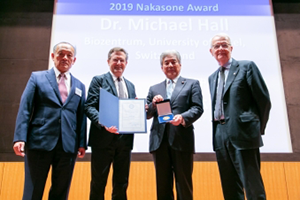 (From left) President NAGATA Shigekazu, Dr. Michael Hall, National Diet member NAKASONE Hirofumi, HFSPO Secretary-General Warwick Anderson
(From left) President NAGATA Shigekazu, Dr. Michael Hall, National Diet member NAKASONE Hirofumi, HFSPO Secretary-General Warwick Anderson
The second part of the ceremony was chaired by SUEMATSU Makoto, president of AMED, and attended by some 100 Japanese high school students. Lectures were delivered by four HFSP research grant awardees who are also Nobel Laureates: Dr.Torsten Wiesel,Dr.HONJO Tasuku, Dr.Jules A. Hoffman, and Dr.Ada Yonath.
In his presentation, entitled “HFSP—a model program for international science,” Dr.Torsten Wiesel talked about how he formulated HFSP’s implementation rules (to require no preliminary data, prohibit selection based on age or gender, and create opportunities for researchers of different fields to come together) with ITO Masao, then president of HFSPO. The creation of the rules was an effort to embody the mission of the program: to elucidate the sophisticated and complex mechanisms of living organisms. Their efforts culminated in active international collaborations among numerous scientists around the world, leading to significant accomplishments.
Under the title “Serendipities of acquired immunity,”Dr.HONJO Tasuku recounted his research on class switch recombination of antibody genes and the PD-1/PD-L1 involvement in immune regulation. When a high school student raised the question, “Why did you become a researcher?” Dr.Honjo answered, “Because researchers can do whatever they want to,” his witty answer delighting the audience.
Dr.Jules A. Hoffman spoke under the title “Innate immunity: from insects to humans,” introducing his research on the Toll-gene using fruit flies.
In her presentation, entitled “From basic science to advanced medicine,” Dr.Ada Yonath gave an insightful explanation on ribosome structure analysis by drawing an analogy with a clip that does not work unless properly shaped, which was easy to understand for the high school students.
*1. Human Frontier Science Program (HFSP): An international basic research support program in life sciences which was launched at the 1987 Venice Summit at the initiative of then prime minister NAKASONE Yasuhiro. The program marked its 30th Anniversary in 2019, for which a commemorative ceremony was held in Japan.
*2. Human Frontier Science Program Organization (HFSPO): Established in 1989 in Strasbourg, France, for the purpose of implementing HFSP.
*3. HFSP Nakasone Award: Established in commemoration of the 20th Anniversary of HFSP, this award commends researchers who have accomplished a prominent breakthrough in biology. All researchers, including HFSP awardees, are eligible candidates for the award.
-
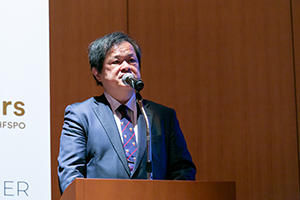 President SUEMATSU Makoto
President SUEMATSU Makoto
-
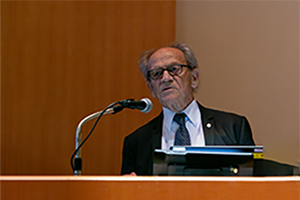 Dr. Torsten Wiesel
Dr. Torsten Wiesel
-
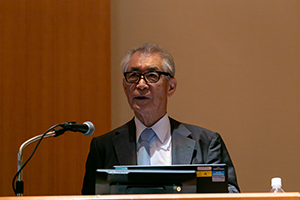 Dr.HONJO Tasuku
Dr.HONJO Tasuku
-
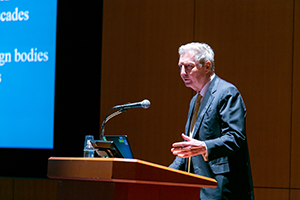 Dr. Jules A. Hoffman
Dr. Jules A. Hoffman
-
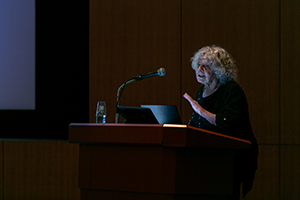 Dr. Ada Yonath
Dr. Ada Yonath
-
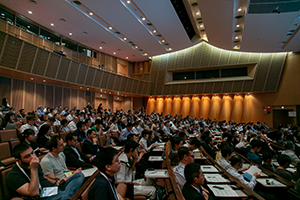 Ceremony
Ceremony
Speaker Profiles
Torsten Wiesel
(President Emeritus, The Rockefeller University)
Former Secretary General of HFSPO (in office from 2000 to 2009)
1981 Awarded the Nobel Prize in Physiology or Medicine for discoveries concerning information processing in the visual system (jointly with David H. Hubel)
Summary of his Nobel Prize-winning research
Our vision works by the light around us being captured by a large number of light-sensitive cells located in the retinas at the back of our eyes. The light is converted into signals that are sent to the cerebral cortex (visual cortex) at the back of the brain via certain neural cells, and there the information is processed into visual impressions. Torsten Wiesel and David Hubel clarified how this process works during the 1960s by experimenting on cats: in the visual cortex, signals are analyzed in sequence by cells with the specific tasks of interpreting contrasts, patterns, and movements. They also showed that this ability develops in children during the initial period after birth.
HONJO Tasuku
(Kyoto University)
1990 Awarded the HFSP research grant for the “Regulation of DNA Rearrangement and Lymphocyte Differentiation”
2018 Awarded the Nobel Prize in Physiology or Medicine for the discovery of cancer therapy by inhibition of negative immune regulation (jointly with James P. Allison)
Summary of his Nobel Prize-winning research
Cancer kills millions of people every year and is one of humanity’s greatest health challenges. By stimulating the inherent ability of our immune system to attack foreign substances in the body, Tasuku Honjo and James Allison have established an entirely new principle for cancer therapy. In 1992, Dr. Honjo discovered a mysterious protein on the surface of immune cells and, after careful exploration of its function, eventually revealed that it operates as a brake on the immune system. Therapies based on his discovery proved to be strikingly effective in the fight against cancer.
Jules A. Hoffman
(University of Strasbourg)
1995 Awarded the HFSP research grant for the “Phylogenetic Perspectives of the Innate Immune Response”
Joint Japanese researcher: Shunji Natori (The University of Tokyo, later RIKEN)
2011 Awarded the Nobel Prize in Physiology or Medicine for discoveries concerning the activation of innate immunity (jointly with Bruce A. Beutler)
Summary of his Nobel Prize-winning research
When bacteria, viruses and other microorganisms attack our bodies, our immune system activates. It has two lines of defense, the innate immunity and the adaptive immunity. Jules Hoffman, along with Bruce Beutler, have contributed to our understanding of how so-called receptors detect microorganisms and activate our innate immunity. In 1996, by studying fruit flies with mutations, Jules Hoffmann showed that the so-called Toll-gene is active in the development of receptors which are crucial for the immune system of the fly.
Ada Yonath
(Weizmann Institute of Science)
2003 Awarded the HFSP research grant for “Novel functional RNAs and drug design by a multidisciplinary theoretical/experimental approach”
Joint Japanese researcher: Isao Tanaka (Hokkaido University)
2009 Awarded the Nobel Prize in Chemistry for studies of the structure and function of the ribosome (jointly with Venkatraman Ramakrishnan and Thomas Arthur Steitz)
Summary of her Nobel Prize-winning research
An organism's vital functions are managed by large, complex protein molecules produced in cells' ribosomes. There, genetic information from "messenger RNA" is translated into chains of amino acids that then build proteins. In the 1970s, Ada Yonath began a project that culminated in 2000 in her successful mapping (together with other researchers) of the structure of ribosomes, which consist of hundreds of thousands of atoms, using x-ray crystallography. Among other applications, this has been important in the production of antibiotics.
Links
Last updated 06/30/20

